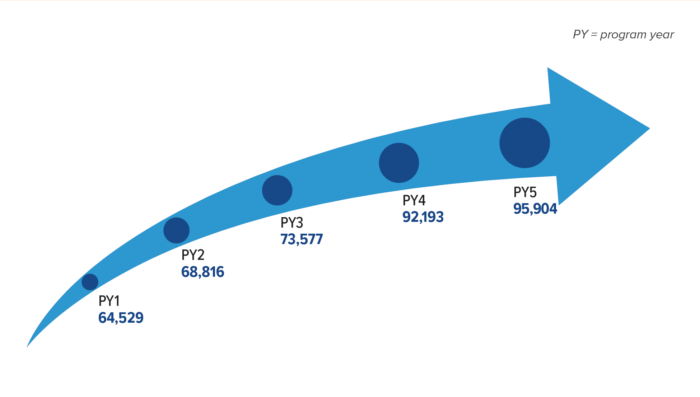There are 1.4 million individuals living with HIV in Kenya, and although the country has made great strides to control the epidemic, there are several counties that have struggled to see the gains. Homabay, as of 2015, faced down an HIV prevalence rate of over 20% (four times the national average). In 2016, The Elizabeth Glaser Pediatric AIDS (EGPAF), began a multi-faceted, 5-year project funded by the U.S. Centers for Disease Control and Prevention. The Timiza-90 project would go on to help individuals in the county move toward realizing the UNAIDS 90-90-90 targets and would enhance health care infrastructure toward lasting change.
TIMIZA-90 AT A GLANCE
Timiza90 is a five-year (Oct. 2016–Sept. 2021) project funded by the U.S. Centers for Disease Control and Prevention (CDC).
OVERALL GOALS
1 Contribute to achievement of the 90-90-90 targets by identifying 90% of people living with HIV (PLHIV), provide antiretroviral therapy (ART) to 90% of those identified as HIV-positive, and ensure viral suppression among 90% of those on ART to ultimately reduce HIV incidence and AIDS-related mortality and to achieve elimination of mother-to-child HIV transmission
2 Bridge gaps in the national health care system, strengthen county leadership coordination to address prevention of mother-to-child transmission (PMTCT) and HIV program oversights, and manage human resources for health
3 Strengthen county health systems for sustainable HIV service delivery
RESULTS
Timiza90 Project Results Against 90-90-90 Targets
First 90
Through enhanced testing strategies including index case finding (including pediatric and adolescent contacts) and partner notification services, a total of 2,964,778 HIV tests were conducted between October 2016 and March 2021, and 45,584 new positives were identified. Through partner notification services, 90,020 index clients were screened, and 212,461 sexual contacts and 25,895 pediatric contacts were elicited. With a testing rate of 80% and 86% for eligible pediatric and sexual contacts, respectively, there were 470 pediatric and 17,668 adult cases identified through partner notification services. Index testing contributed 46% of the positives identified.
Second 90
By integrating services and adopting a one-stop shop (same-day ART initiation in maternal and child health units, comprehensive care clinics, TB clinics, and child wellness centers), Timiza90 initiated a total of 39,019 clients on ART, including 2,598 children younger than 15 between October 2016 and March 2021. As of March 2021, the project currently supports 95,904 clients for ART. Through differentiated service delivery, Elizabeth Glaser Pediatric AIDS Foundation was able to get more individuals on optimized ART throughout the duration of the project.

Third 90
Various strategies including enhanced digital technology for better patient tracking, peer-to-peer support implementation, and better ART formulations enabled Timiza90 to ensure ART access to 95,904 children and adults. The project realized a growth of 34,988 clients on ART. Lost to follow-up rates improved vastly, moving from 29% in May 2020 to less than 5% in November 2020.
Concentrated Efforts in PMTCT
Designation of PMTCT focal persons at sites, enhancement of early antenatal care (ANC) attendance, and community mapping of pregnant women contributed to the success in PMTCT. Due to these efforts, coupled with the implementation of quality improvement initiatives in PMTCT access to mother–infant pairs at highest risk of vertical transmission, the absolute number of HIV-positive infants was reduced from 209 in 2016–2017 to 86 in 2019–2020.
Further preventing HIV transmission, the project performed 47,550 voluntary medical male circumcisions (VMMCs) over the course of its five years.
Reaching the Unreachable: Unbiased, Informed, and Innovative Programing for Individuals Most at Risk of HIV Infection (Key Populations)
Working hand-in-hand with communities to identify ways to access men who have sex with men (MSM), people who inject drugs (PWID), migratory tradespersons including fishermen and fisherwomen, female sex workers (FSWs), and transgender persons, Elizabeth Glaser Pediatric AIDS Foundation (EGPAF) was able to reach these individuals with individualized and nondiscriminatory counseling, treatment, and adherence support.
As of March 2021, the project has enrolled 34,365 members of key populations (KPs), out of which 3,649 are HIV positive (10.6% positivity). Pre-exposure prophylaxis (PrEP) uptake is at 62% of the eligible, with a 91% retention rate at one month and an 87% rate at three months, observed across these populations. One seroconversion has been reported.

















